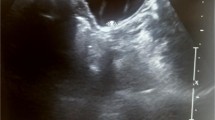Abstract
The purpose of the study is to evaluate the efficacy and safety of shock wave lithotripsy (SWL) using sciaticum majus foramen and sciaticum minus foramen as the path to treat distal ureteral stone in supine position. Between December 2006 and November 2008, 243 cases of distal urinary calculi were treated in our department using SWL or ureteroscopy. 189 cases for SWL were treated in supine position. The shockwave target on the stone in distal ureter via sciaticum majus foramen and sciaticum minus foramen, avoiding the sacroiliac joint. 54 cases were underwent ureteroscopy combined with holmium:YAG laser lithotripsy. The stone-free rate and the efficacy quotient (EQ) for SWL and ureteroscopy was 81.5%, 0.68; 94.4%, 0.78; respectively (p = 0.02). The retreatment rate for SWL and ureteroscopy was 14.6%, 0, respectively. The number of the shocks ranged from 600 to 3,000 (mean 2,566.3 ± 378.8). The energy per pulse of SWL ranged from 8 to 12 kV (mean 10.7). SWL in the supine position using sciaticum majus foramen and sciaticum minus foramen as the path is a choice of the treatment of distal ureteral stones with an excellent success rate and low side effect.


Similar content being viewed by others
References
Graff J, Diederichs W, Shulze H (1988) Long-term followup in 1003 extracorporeal shock wave lithotripsy patients. J Urol 140:479–483
Tiselius HG, Ackermann D, Alken P et al (2006) Ureteral stones clinical guidelines panel summary report of the management of ureteral calculi. Eur Urol Assoc 18:271
Preminger GM, Tiselius HG, Assimos DG, Alken P, Buck C, Gallucci M, Knoll T, Lingeman JE, Nakada SY, Pearle MS, Sarica K, Türk C, Wolf JS Jr, EAU/AUA Nephrolithiasis Guideline Panel (2007) 2007 guideline for the management of ureteral calculi. J Urol 178:2418–2434
Jenkins AD, Gillenwater JY (1988) Extracorporeal shock wave lithotripsy in the prone position. Treatment of stones in the distal ureter or anomalous kidney. J Urol 139:911–915
Segura JW, Preminger GM, Assimos DG et al (1997) Ureteral stones clinical guidelines panel summary report on the management of ureteral calculi. J Urol 158:1915–1921
El-Assmy A, El-Nahas AR (2007) Does degree of hydronephrosis affect success of extracorporeal shock wave lithotripsy for distal ureteral stones? Urology 69:431–435
Honeck P, Hacker A, Alken P et al (2006) Shock wave lithotripsy versus ureteroscopy for distal ureteral calculi: a prospective study. Urol Res 31:1–3
Shapiro A, Meretyk S, Katz G et al (1992) Extracorporeal shock-wave lithotripsy (ESWL) monotherapy for stones in lower ureter. Urology 40:132–136
Sun X (2006) Medical shockwave [M]. Chinese Science and Technique Press, Beijing, pp 404–406
Ahlawat RK, Bhandari M, Kumar A, Kapoor R (1991) Treatment of ureteral calculi with extracorporeal shock wave lithotripsy using the Lithostar device. J Urol 146:737–741
Amiel J, Touabi K, Peyrottes A, Toubol J (1990) Extracorporeal piezoelectric lithotripsy in the treatment of calculi of the ureter. Apropos of a series of 143 cases. Ann Urol (Paris) 24:135–139
Goktas S, Peskircioglu L, Tahmaz L, Kibar Y, Erduran D, Harmankaya C (2000) Is there significance of the choice of prone versus supine position in the treatment of proximal ureter stones with extracorporeal shock wave lithotripsy? Eur Urol 38:618–620
Guntekin E, Kukul E, Kayacan Z et al (1994) Morbidity associated with patient positioning in extracorporeal shock wave lithotripsy of distal ureteral calculi. Int Urol Nephrol 26(l):13–16
Becht E, Moll V, Neisius D, Ziegler M (1988) Treatment of prevesical ureteral calculi by extracorporeal shock wave lithotripsy. J Urol 139:916–918
Miller K, Hautmann R (1987) Treatment of distal ureteral calculi with SWL: experience with more than 100 consecutive cases. World J Urol 5:259–261
Ackaert KS, Dik P, Lock MT, Kurth KH, Schroder FH (1989) Treatment of distal ureteral stones in the horse riding position. J Urol 142:955–957
Yates J, Zabbo A, Pareek G (2007) A comparison of the FREDDY and Holmium lasers during ureteroscopic lithotripsy. Lasers Surg Med 39:637–640
Pace DT, Weir MJ, Tariq N et al (2000) Low success rate of repeat shock wave lithotripsy for ureteral stones after failed initial treatment. J Urol 164:1905–1907
Tligui M et al (2003) Emergency extracorporeal shock wave lithotripsy (ESWL) for obstructing ureteral stones. Eur Urol 43(5):552–555
Strohmaier WL et al (1999) Comparison of extracorporeal shock wave lithotripsy and ureteroscopy in the treatment of ureteral calculi: a prospective study. Eur Urol 36:376–379
Author information
Authors and Affiliations
Corresponding author
Rights and permissions
About this article
Cite this article
Lu, J., Sun, X. & He, L. Sciaticum majus foramen and sciaticum minus foramen as the path of SWL in the supine position to treat distal ureteral stone. Urol Res 38, 417–420 (2010). https://doi.org/10.1007/s00240-010-0285-2
Received:
Accepted:
Published:
Issue Date:
DOI: https://doi.org/10.1007/s00240-010-0285-2




